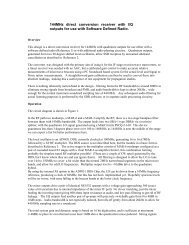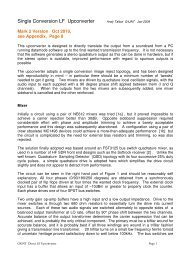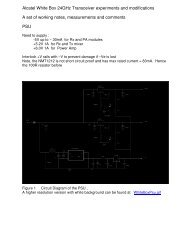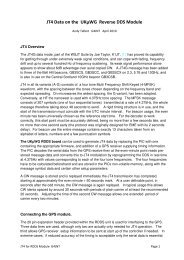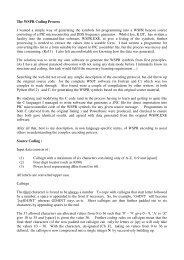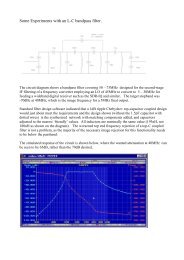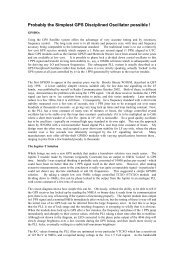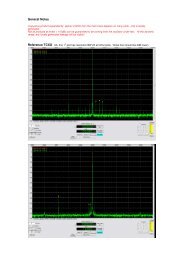Software Manual - G4JNT
Software Manual - G4JNT
Software Manual - G4JNT
You also want an ePaper? Increase the reach of your titles
YUMPU automatically turns print PDFs into web optimized ePapers that Google loves.
The calculation 100* (64K + Rho’) / (64K – Rho’) is then made which is converted to BCD, a decimal<br />
point inserted and sent to the display as VSWR in the range 0 to 99.99 Refer to the .ASM listing for<br />
full details, as the promotion and scaling needed for the integer maths gets a bit involved.<br />
Hopefully the comments in the assembler listing explain the processes satisfactorily.<br />
Linearity and Diode Drops<br />
The SWR and power calculations assume the voltage in is linearly related to RF power which is not<br />
the case for diode power detectors. While it would be possible to insert a fixed value of diode drop<br />
into the PIC calculation, or even a first or second order approximation without too much effort it<br />
was decided this would complicate things too much. If the SWR head is designed to give 10 – 15V<br />
for full output power, then the effect of the diode drop on the resulting SWR and Power values is<br />
minimal. Accuracy worsens at lower power levels as voltage drops, but reading accuracy, especially<br />
SWR, are in most practical cases of less importance here.<br />
As an exercise in programming, try adding a fixed ‘diode drop’ voltage to the FWD and REF readings.<br />
Assume say 0.65V constant drop, and work this out in terms of a 4.096V reference with a 10 bit A/D<br />
(all right, its equal to 162). Adding this to each raw A/D reading is the simplest solution.<br />
Frequency Counter<br />
The FreqMeter software implements a frequency counter with selectable gate times of 10ms,<br />
100ms and 1s allowing 100Hz, 10Hz and 1Hz frequency readout resolution respectively.<br />
The 16F628 PIC is used in this design ( although the 16F819 has all the necessary peripherals there<br />
are a few subtle differences in setting up and EEProm reading). A useful peripheral function inside<br />
this PIC is a 16 bit counter / timer – TIMER1 - that can be clocked at several tens of MHz from an<br />
external source, and read by the PIC . The vagaries of allocation of I/O pins means the input has to<br />
be made via PORTB, 6 which is one of those brought out to the 4-pin header otherwise used for incircuit<br />
programming . The one labelled C. This has a Schmitt trigger input, so add an external pair of<br />
resistors of around 1kΩ each to bias at Vcc / 2 and AC couple the RF onto this pin though a capacitor<br />
of 100nF. A RF input of 4dBm or more in then enough to operate the counter.<br />
The data sheet is a bit vague about the maximum speed capability of this counter – suggesting it is<br />
20MHz, the same as the processor clock. However, actual tests (on a not-very-statistically-valid set<br />
of two chips from the same batch) show that it will run at frequencies up to about 80MHz; so to<br />
play safe lets just call it 50MHz maximum.<br />
For normal operation with the stored IF offset, turn on<br />
and after an introductory message the display shown<br />
will appear. To toggle gate times press the button to<br />
shift though 10/100/1000ms. On the 1s gate time<br />
setting, the button may have to be held pressed for up<br />
to 1s before it is detected.<br />
<strong>G4JNT</strong> PIC Controller <strong>Software</strong> <strong>Manual</strong>. Page 5



